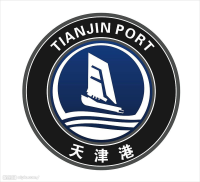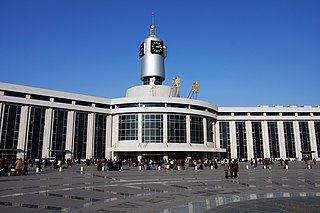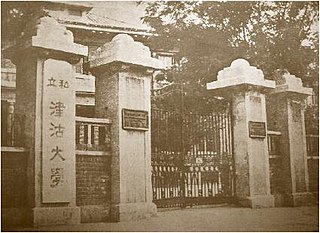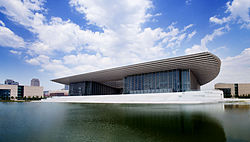
Tianjin is a direct-administered municipality in Northern China on the shore of the Bohai Sea. It is one of the nine national central cities, with a total population of 13,866,009 inhabitants at the time of the 2020 Chinese census. Its metropolitan area, which is made up of 12 central districts, was home to 11,165,706 inhabitants and is also the world's 29th-largest agglomeration and 11th-most populous city proper.

The Shanghai Grand Theatre is a complex located at the intersection of Renmin Avenue and Huangpi North Road in the northern part of the People's Square in the Huangpu District of Shanghai. The building houses the Shanghai Opera House and other performing companies.

Tianjin University, previously Peiyang University (北洋大學), is a national public research university in Tianjin, China. Established in 1895 by a royal charter from Guangxu Emperor, Tianjin University is the oldest university in China, leading the country's significant shift towards modernization and development. The university is affiliated with and funded by the Ministry of Education of China. It is part of Project 211, Project 985, and the Double First-Class Construction.
The Tianjin University of Science and Technology is a municipal public university in Binhai, Tianjin, China. It is affiliated with the City of Tianjin and funded by the municipal government. Founded as Hebei Institute of Light Industry in 1958, it received university status in 2002.

The Hong Kong Cultural Centre (香港文化中心) is a public multipurpose performance facility in Tsim Sha Tsui, Hong Kong. Located at Salisbury Road, it was built by the former Urban Council and, since 2000, has been administered by the Leisure and Cultural Services Department of the Hong Kong Government. A wide variety of cultural performances are held here.

The National Centre for the Performing Arts (NCPA) (国家大剧院), colloquially described as The Giant Egg (巨蛋), is an arts centre containing an opera house in Xicheng, Beijing, China. Designed by French architect Paul Andreu, the NCPA opened in 2007 and is the largest theatre complex in Asia. The NCPA is semi-spherical in appearance, with a long axis length of 212.20 meters in the east-west direction, a short axis length of 143.64 meters in the north-south direction, a height of 46.285 meters, an area of 119,900 square meters, and a total construction area of approximately 165,000 square meters, including 105,000 square meters of main buildings and 60,000 square meters of underground, auxiliary facilities, with a total cost of 3.067 billion yuan. The centre contains an opera hall, music hall, theater and art exhibition halls, restaurants, audio shops, and other supporting facilities.

Guo Degang is a Chinese crosstalk (xiangsheng) comedian and actor. Guo's film appearances include The 601st Phone Call, Just Another Pandora's Box, and Mystery. Guo has also directed the films Our Happiness and The Faces of My Gene.

The Port of Tianjin, formerly known as the Port of Tanggu, is the largest port in Northern China and the main maritime gateway to Beijing. The name "Tianjin Xingang", which strictly speaking refers only to the main seaport area, is sometimes used to refer to the whole port. The port is on the western shore of the Bohai Bay, centred on the estuary of the Haihe River, 170 km southeast of Beijing and 60 km east of Tianjin city. It is the largest man-made port in mainland China, and one of the largest in the world. It covers 121 square kilometers of land surface, with over 31.9 km of quay shoreline and 151 production berths at the end of 2010.

Tianjin railway station is the principal railway station in Tianjin, China. It was established in 1888, rebuilt in 1987–1988, and restructured in 2007–2008. Its Chinese big title was written by Deng Xiaoping in 1988, for celebrating 100th anniversary of its founding.

Beijing People's Art Theatre (北京人民艺术剧院/北京人民藝術劇院) is a theatre company that was founded in June 1952 by drama master Cao Yu. Since its founding, the company has produced nearly 300 dramas of different styles, from classic Chinese themes to adaptations of Molière. The theater company is under the Beijing Municipal Committee of the Chinese Communist Party and is based in the Capital Theatre in Beijing.

The Port of Tianjin is divided into nine areas: the three core areas of Beijiang, Nanjiang, and Dongjiang around the Xingang fairway; the Haihe area along the river; the Beitang port area around the Beitangkou estuary; the Dagukou port area in the estuary of the Haihe River; and three areas under construction.
The Port of Tianjin, formerly known as the Port of Tanggu, is the largest port in Northern China and the main maritime gateway to Beijing. The name "Tianjin Xingang"(Chinese: 天津新港; pinyin: tiānjīn xīngǎng; lit. 'Tianjin New Port'), which strictly speaking refers only to the main seaport area, is sometimes used to refer to the whole port. The Port is located on the western shore of the Bohai Bay, centered on the estuary of the Haihe River, 170 km south east of Beijing and 60 km east of Tianjin city. It is the largest man-made port in mainland China, and one of the largest in the world. It covers 121 square kilometers of land surface, with over 31.9 km of quay shoreline and 151 production berths at the end of 2010.
The Port of Tianjin falls under the supervisory and regulatory purview of the Tianjin Municipality People’s Government. The 2004 incorporation of the Tianjin Port Authority into TPG formally divested the group of its role as Port Regulator, which passed to the Tianjin Transportation and Port Authority (天津市交通运输和港口管理局), formerly the Tianjin Transport Commission. The TTPA implements state policy on port work; drafts local policies, by-laws and regulations; and licenses, audits, and issues certifications to businesses operating in the port, in particular to ship terminals. The TTPA supervises and manages compliance to all laws and regulations regarding environmental protection, service compliance, pilotage, maintenance of port infrastructure and handling of dangerous goods and disinfection in all terminals and storage areas.
The Port of Tianjin, formerly known as the Port of Tanggu, is the largest port in Northern China and the main maritime gateway to Beijing. The name "Tianjin Xingang"(Chinese: 天津新港; pinyin: tiānjīn xīngǎng; lit. 'Tianjin New Port'), which strictly speaking refers only to the main seaport area, is sometimes used to refer to the whole port. The Port is located on the western shore of the Bohai Bay, centered on the estuary of the Haihe River, 170 km south east of Beijing and 60 km east of Tianjin city. It is the largest man-made port in mainland China, and one of the largest in the world. It covers 121 square kilometers of land surface, with over 31.9 km of quay shoreline and 151 production berths at the end of 2010.
Wellington College International Tianjin is a British international school in Hongqiao District, Tianjin. It is affiliated with Wellington College in Berkshire, England and serves students 2-18; senior school serves ages 11–18.
The Hunan Grand Theatre is a large-scale performing arts center in Changsha, Hunan, China, opened in November 1998. It was designated a national cultural demonstration site in 2010. Its main hall has a capacity of 1,460 spectators.

Guoba Cuisine, is a kind of authentic speciality and typical breakfast in Tianjin, China. There is nowhere to find its specific origin, as it is said to have a history of over 300 years. Guoba Cuisine is well known for its salty but delicious taste. It used to be divided into two categories: vegetarian and meat, though only the vegetarian version is still popular today. Dafulai Guoba Cuisine is the most representative time-honored brand in terms of Guoba Cuisine in Tianjin. In 1997, Dafulai Guoba cuisine was ranked among the first batch of "Famous Chinese Snacks" by the Chinese Cooking Association. Its cooking techniques had also already been listed in the second batch of Intangible Cultural Heritage of Tianjin city in 2009.

The Tianjin State Security Bureau is a bureau of the Chinese Ministry of State Security in Tianjin which serves as the direct-administered municipality's intelligence service and secret police. Established in December 1983 from parts of the Tianjin public security bureau and Tianjin Investigation Department, the bureau engages in global espionage operations far beyond the confines of the city, with an emphasis on operations against Japan and cyberespionage capabilities. In an indictment, the United States government has accused the bureau of being behind the advanced persistent threat (APT) known as Red Apollo (APT10).

Tsin Ku University, was a Jesuit Catholic university established by the French Jesuits in Tianjin, China. It was the second Catholic university in China and one of the earliest universities in modern China to offer architectural education. Founded in 1921, its official name was originally French: Institut des Hautes Études Industrielles et Commerciales de Tientsin, translated into Chinese as 天津工商大学. In August 1933, it was officially registered under the Ministry of Education of the Nationalist Government as Private Tientsin Kung Shang College (私立天津工商学院). In October 1948, it was restructured into a university and named Private Tsin Ku University (私立津沽大学). In September 1951, it was converted from private to public and became subordinate to the Ministry of Education. In August 1952, as part of higher education restructuring, Tsin Ku University was dissolved. The engineering college merged into Tianjin University, the school of finance and economics merged into Nankai University, and based on its former campus, the Teacher Training College of Tsin Ku University became Tianjin Teacher Training College, which later evolved into Hebei University. In November 1970, Hebei University relocated to Baoding. Some faculty and students who did not move established Tianjin Foreign Studies Institute on the original Tsin Ku University campus, which has since been upgraded to Tianjin Foreign Studies University.























